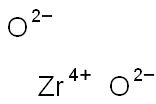산화지르코늄 C화학적 특성, 용도, 생산
화학적 성질
Zirconium dioxide is a white, amorphous powder, insoluble
in water but slightly soluble in acid.
물리적 성질
Monoclinic zirconia
(baddeleyite structure) stable
below 1197°C, tetragonal
zirconia (rutile structure) stable
between 1197 and 2300°C, cubic
zirconia (fluorine structure)
stable above 2300°C or at lower
temperature if stabilized by
addition of magnesia, calcia or
yttria. Maximum service
temperature 2400°C. Zirconia
starts to act as an oxygen anion
conductor at 1200°C. Highly corrosion resistant to molten
metals such as Bi, Hf, Ir, Pt, Fe,
Ni, Mo, Pu, and V. Strongly
attacked by liquid metals Be, Li,
Na, K, Si, Ti, Zr, and Nb.
Insoluble in water, but slowly
soluble in HCl and HNO
3; soluble in boiling concentrated
H
2SO
4 and alkali hydroxides but readily attacked by HF.
물리적 성질
White, heavy, amorphous powder or monoclinic crystals; refractive index 2.13; density 5.68 g/cm
3; Mohs hardness 6.5; transforms to tetragonal structure above 1,100°C and cubic form above 1,900°C; melts at 2,710°C and vaporizes at about 4,300°C; insoluble in water; soluble in hydrofluoric acid and hot sulfuric, nitric and hydrochloric acids.
용도
Lanthanum-modified lead zirconate titanate (PLZT) fibers with a diameter of around 300 microns were produced by a thermoplastic processing method. The main use of zirconia is in the production of ceramics with other uses including as a protective coating on particles of titanium dioxide pigments, as a refractory material, in insulation, abrasives and enamels. Stabilized zirconia is used in oxygen sensors and fuel cell membranes because it has the ability to allow oxygen ions to move freely through the crystal structure at high temperatures. This high ionic conductivity (and a low electronic conductivity) makes it one of the most useful electroceramics.Zirconium dioxide is also used as the solid electrolyte in electrochromic devices. Zirconia is a precursor to the electroceramic lead zirconate titanate (PZT), which is a high-K dielectric, which is found in myriad components.
일반 설명
Zirconium(IV) oxide (ZrO
2) which is also known as zirconia is a ceramic nanoparticle that can be used as a nano-filler. It can be incorporated in a variety of polymer and metal composites to improve the thermo-mechanical properties of the base material.
공업 용도
There are several types of zirconia: a pure(monoclinic) oxide and a stabilized (cubic)form, and a number of variations such asyttria- and magnesia-stabilized zirconia andnuclear grades. Stabilized zirconia has a highmelting point, about 2760°C, low thermal conductivity,and is generally unaffected by oxidizingand reducing atmospheres and mostchemicals. Yttria- and magnesia-stabilized zirconiasare widely used for equipment and vesselsin contact with liquid metals. Monoclinicnuclear zirconia is used for nuclear fuel elements,reactor hardware, and related applicationswhere high purity (99.7%) is needed.Zirconia has the distinction of being an electricalinsulator at low temperatures, graduallybecoming a conductor as temperaturesincrease.
Carcinogenicity
To simulate the chronic alpha radiation of Thorotrast, the
liver of female Wistar rats was exposed to fractionated
neutron irradiation at 14-day intervals (0.2Gy per fraction)
over 2 years to a total dose of 10.0Gy. Before the start of
irradiation, half of the animals received 120 mL of nonradioactive
Zirconotrast (ZrO2), which is comparable to
Thorotrast in all other physical and chemical properties.
The first liver tumor was detected 1 year after the beginning
of irradiation. At the end of the life span study, the
incidence of irradiated animals with liver tumors was about
40%. In the animals treated additionally with ZrO2, the
incidence, time of onset, and overall number of liver
tumors were nearly equal, indicating that the fractionated
neutron irradiation was the exclusive cause of tumor
development. The lifelong-deposited ZrO2 colloid had
no influence on tumor induction or development. Histological
types of benign and malignant liver tumors seen in
this study were the same as those seen in animals treated
with Thorotrast.
산화지르코늄 준비 용품 및 원자재
원자재
준비 용품









